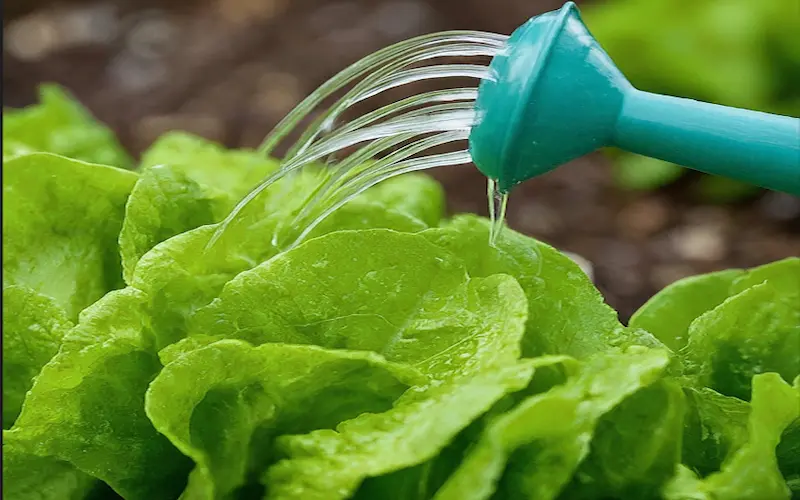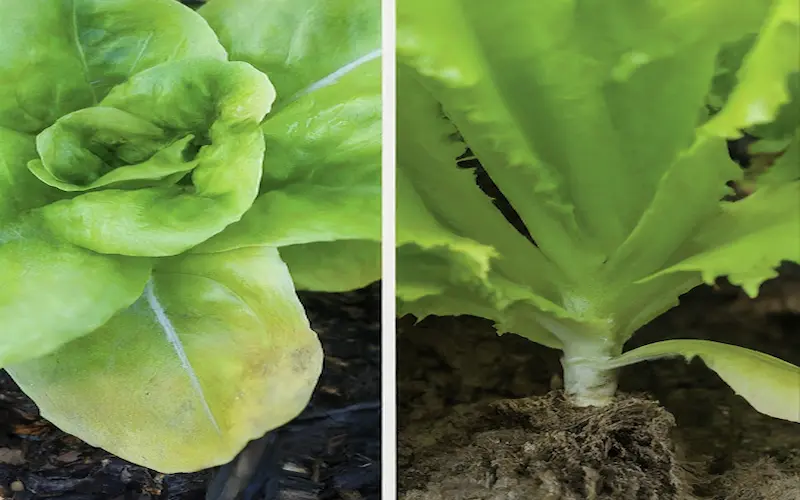The Ultimate Guide: How Often to Water Lettuce for Optimum Growth
Published: 10 Jul 2024
The importance of proper watering for lettuce plants
As an avid gardener, I cannot overstate the significance of proper watering for the health and vitality of lettuce plants. Water is the lifeblood of these leafy greens, crucial for achieving optimum growth and a bountiful harvest. Lettuce plants are relatively shallow-rooted and have a high water requirement, making them particularly sensitive to water stress.
In this comprehensive guide, I will explain the various factors that influence watering frequency and explore the signs of over- and underwatering. I also provide practical tips and techniques to help you achieve optimum growth for your lettuce plants. This guide will equip you with the knowledge and skills to cultivate a thriving lettuce crop.

Factors to consider when determining how often to water lettuce
There are several factors come into play. Here are some key considerations:
1. Soil Type: The soil’s composition plays a significant role in water retention and drainage. Sandy soils drain quickly and require more frequent watering, while clay soils hold moisture for extended periods, necessitating less frequent watering.
2. Weather Conditions: Temperature, humidity, wind, and sunlight exposure all impact the rate at which soil dries out. Lettuce plants require frequent watering to compensate for increased evaporation and transpiration during hot, dry, and windy conditions.
3. Growth Stage: Lettuce plants have different water requirements at various growth stages. Seedlings and young plants have shallow roots and require consistent, light watering, while mature plants with deeper roots can tolerate slightly drier conditions.
4. Container vs. In-ground Planting: Lettuce grown in containers tends to dry out faster than those planted in the ground. Containers have limited soil volume and are more exposed to airflow, requiring more frequent watering.
5. Mulching: Organic mulches, such as straw or bark chips, help retain soil moisture and reduce the frequency of watering needed.
By considering these factors, you can tailor your watering schedule to the specific needs of your lettuce plants, ensuring they receive the optimal amount of moisture for their growth and development.
Signs of overwatering and underwatering in lettuce plants
Recognizing the signs of over- and underwatering is crucial for maintaining healthy lettuce plants and taking corrective action when necessary. Here are some common indicators to watch out for:

Signs of Overwatering:
6. Wilting Leaves: While wilting is typically associated with underwatering, it can also occur when the soil is saturated and the roots cannot breathe.
7. Yellow or Brown Leaves: Excessive moisture can cause the leaves to turn yellow or brown, starting from the lower leaves and working up.
8. Stunted Growth: Overwatered lettuce plants may exhibit stunted growth and fail to reach their full potential.
9. Soft, Mushy Stems: Stems that feel soft and mushy to the touch can indicate root rot caused by excessive moisture.
10. Fungal Growth: Overly wet conditions can promote the growth of fungal diseases, such as powdery mildew or downy mildew, which can further compromise the plant’s health.
Signs of Underwatering:
11. Wilting Leaves: One of the most apparent signs of underwatering is wilted, drooping leaves, which can eventually turn crisp and dry.
12. Slow Growth: Lettuce plants not receiving enough water will experience stunted growth and may produce smaller, less flavorful leaves.
13. Dry, Crumbly Soil: The plant needs water if the soil appears dry and crumbly.
14. Leaf Discoloration: Severe underwatering can cause the leaves to turn yellow or brown or develop purplish tints.
15. Bolting: Lack of water can trigger the plant’s stress response, causing it to bolt (produce a flowering stem) prematurely, resulting in bitter-tasting leaves.
By regularly monitoring your lettuce plants and recognizing these signs, you can immediately adjust your watering schedule and ensure your plants receive the optimal amount of moisture.
General guidelines for watering lettuce plants
While specific watering requirements may vary based on the factors mentioned earlier, here are some general guidelines to help you establish a suitable watering routine for your lettuce plants:
16. Water Deeply: Instead of frequent, shallow watering, aim to water deeply, ensuring the moisture penetrates at least 6 inches into the soil. This encourages more profound root growth and helps the plants withstand drought.
17. Consistent Moisture: Lettuce plants prefer moist soil, not waterlogged. Aim to keep the soil evenly moist without letting it dry out completely or become saturated.
18. Early Morning Watering: Water your lettuce plants early in the morning. This allows the plants to absorb moisture before the day’s heat sets in, reducing evaporation and minimizing the risk of fungal diseases.
19. Check Soil Moisture: Before watering, check the soil moisture level by sticking your finger into the soil up to the second knuckle. If the soil feels dry, it’s time to water; if it’s still moist, hold off until it starts to dry out.
20. Adjust as Needed: As your lettuce plants grow and environmental conditions change, be prepared to adjust your watering frequency accordingly. Monitor the plants closely and adapt to maintain optimal soil moisture levels.
Regularly monitoring your plants and adjusting your watering routine is critical to ensuring their optimal growth and health.
Methods of Watering Lettuce Plants
There are several methods you can employ to water your lettuce plants effectively. Each method has advantages and is more suitable for certain growing conditions or personal preferences. Here are some popular watering methods to consider:
21. Hand Watering: This traditional method involves using a watering can or a hose with a gentle spray nozzle. Hand watering allows you to target specific areas and ensure an even water distribution around the plant’s root zone. It’s beneficial for small garden beds or container-grown lettuce.
22. Drip Irrigation: A drip irrigation system consists of tubing or soaker hoses that slowly release water directly into the soil, minimizing water loss through evaporation or runoff. This highly efficient method can be automated with a timer, making it convenient for more extensive plantings or when you’re away from your garden.
23. Sprinklers: Overhead sprinklers can effectively water lettuce plants, especially in more extensive garden beds or rows. However, it’s essential to water early in the morning or late evening to reduce evaporation and minimize the risk of fungal diseases that can develop from prolonged leaf wetness.
24. Furrow Irrigation: This method involves creating shallow trenches or furrows between rows of lettuce plants and allowing water to flow through them. As the water seeps into the soil, it provides moisture to the plant’s root systems. Furrow irrigation can efficiently water more extensive plantings but may require more frequent applications.
25. Wicking Beds or Self-Watering Containers: Wicking beds or self-watering containers can be an excellent option for container or raised bed gardening. These systems utilize a reservoir of water drawn into the soil through capillary action, providing consistent moisture to the plants’ roots.
The choice of watering method will depend on factors such as the size of your garden, the available water source, and your personal preferences. Experiment with different techniques to find the best one for your lettuce plants and gardening setup.
Best time of day to water lettuce plants
The timing of watering your lettuce plants significantly impacts their overall health and growth. At the same time, the specific watering schedule may vary based on weather conditions and soil type. Gardeners and horticulturists agree on the best time of day to water lettuce plants.
The ideal time to water lettuce is early morning, typically between 6 AM and 10 AM. Here are a few reasons why early morning watering is recommended:
26. Reduced Evaporation: During the more excellent morning hours, evaporation from the soil and transpiration from the plants is lower compared to the hotter midday or afternoon periods. This means that more water is absorbed by the plants and retained in the soil, reducing water waste.
27. Leaf Drying: Watering in the morning allows the leaves to dry off before nightfall, minimizing the risk of fungal diseases and other moisture-related issues that can develop when leaves remain wet overnight.
28. Root Absorption: In the morning, the soil is typically more relaxed, and the plants’ roots absorb water and nutrients more actively. This ensures the plants can make the most of the water and nutrients provided during this time.
29. Reduced Wind: Early morning hours tend to be less windy, which helps prevent water from being blown away or distributed unevenly, ensuring more efficient watering.
30. Photosynthesis Boost: When lettuce plants receive water in the morning, they can begin the process of photosynthesis more efficiently, as the leaves are hydrated and ready to absorb sunlight for energy production.
While early morning is generally considered the best time to water lettuce plants, there may be exceptions based on your specific growing conditions or personal schedule. For instance, if you live in a scorching and dry area, you may need to supplement with additional evening watering to prevent excessive moisture loss during the day.
Adjusting watering frequency based on weather conditions
While establishing a consistent watering routine is essential for the health of your lettuce plants, it’s equally important to be flexible and adjust your watering frequency based on changing weather conditions. Environmental factors such as temperature, humidity, wind, and rainfall can significantly impact the moisture requirements of your plants. Here’s how you can adapt your watering schedule to accommodate various weather scenarios:
31. Hot and Dry Conditions: Lettuce plants lose moisture more rapidly through evaporation and transpiration during high temperatures and low humidity. In such conditions, you may need to increase the watering frequency to prevent the soil from drying out too quickly. Monitor the soil moisture levels closely and water more often, possibly twice a day if necessary.
32. Rainy or Humid Conditions: When the weather is rainy or humid, the soil retains moisture for more extended periods, reducing the need for frequent watering. During these times, you can reduce the watering frequency or even skip watering altogether if the soil remains consistently moist. However, be cautious of overwatering, as excessive moisture can lead to root rot and other issues.
33. Windy Conditions: Strong winds can accelerate the soil surface’s evaporation rate and plants’ transpiration. In windy conditions, you may need to water more frequently to compensate for the increased moisture loss. Additionally, consider using a watering method that minimizes water loss due to wind, such as drip or furrow irrigation.
34. Seasonal Changes: As the seasons transition, your lettuce plants’ water requirements may change. During the cooler months of spring and fall, the plants may require less frequent watering than during the hot summer months. Adjust your watering schedule to match the changing weather patterns and plant growth stages.
35. Mulching: Applying a layer of organic mulch, such as straw, leaves, or bark chips, around your lettuce plants can help retain soil moisture and reduce the need for frequent watering, especially during hot and dry conditions.
Monitoring your plants closely and observing the soil moisture levels is essential to effectively adjust your watering frequency based on weather conditions. Pay attention to signs of water stress, such as wilting or discolored leaves, and adjust as needed. Additionally, consider using weather forecasts and local climate data to anticipate changes in weather patterns and plan your watering schedule accordingly.
Watering tips for different stages of lettuce growth
Lettuce plants have distinct water requirements at various stages of their growth cycle. Understanding these needs and adjusting your watering practices accordingly. It can help ensure optimal growth and prevent stunted development, bolting, or disease susceptibility. Here are some watering tips for different stages of lettuce growth:
36. Seedling Stage:
· Water gently and frequently, keeping the soil moist but not waterlogged.
· Use a fine mist or gentle watering can to avoid disturbing the delicate seedlings.
· Avoid letting the soil dry out completely, as this can stunt seedling growth or cause them to wilt.
37. Transplanting Stage:
· Water the transplants thoroughly immediately after planting to help them establish roots.
· Continue watering regularly, keeping the soil moist but not saturated.
· Provide shade or mulch around the transplants to reduce moisture loss and stress.
38. Vegetative Growth Stage:
· As the lettuce plants grow larger, increase the volume and frequency of watering to accommodate their increasing water needs.
· Water deeply, aiming to moisten the soil to a depth of at least 6 inches.
· Maintain consistent soil moisture, but allow the top inch or two to dry out slightly between waterings.
39. Heading or Bolting Stage:
· During the heading or bolting stage, lettuce plants may require more frequent watering to support the development of the dense head or flowering stalk.
· Ensure the soil remains consistently moist, but avoid waterlogging, which can lead to root rot or disease issues.
40. Harvest Stage:
· As you harvest the lettuce leaves or heads, gradually reduce the watering frequency.
· Avoid overwatering during this stage, which can lead to leaf spoilage or encourage disease development.
Providing the right amount of water at the right time can help your lettuce plants thrive and produce a bountiful harvest of crisp, flavorful greens.
Common mistakes to avoid when watering lettuce
Even with the best intentions, making mistakes when watering lettuce plants is easy. These mistakes can lead to various issues, from stunted growth and poor yields to disease problems and even plant death. To help you avoid these pitfalls, here are some common mistakes to be aware of and strategies to prevent them:
41. Overwatering:
· Overwatering is one of the most common mistakes when caring for lettuce plants. Excessive moisture can lead to root rot, fungal diseases, and nutrient deficiencies.
· To avoid overwatering, always check the soil moisture level before watering and ensure the soil has partially dried out before adding more water.
· Additionally, ensure proper drainage in your garden beds or containers to prevent waterlogging.
42. Underwatering:
· On the other end of the spectrum, underwatering can be just as detrimental to lettuce plants. Insufficient water can lead to wilting, stunted growth, and even bolting (premature flowering).
· Monitor your plants closely and water when the top inch or two of soil feels dry.
· Adjust your watering schedule based on weather conditions and the growth stage of your lettuce plants.
43. Watering at the Wrong Time:
· Watering during the hottest day can lead to excessive evaporation and water loss.
· Aim to water your lettuce plants in the early morning or late evening when temperatures are more relaxed and evaporation rates are lower.
· Avoid watering at night, as prolonged leaf wetness can promote fungal diseases and other moisture-related issues.
44. Inconsistent Watering:
· Lettuce plants thrive on consistent moisture levels in the soil. Irregular or inconsistent watering can stress the plants and lead to problems such as tip burn, bitterness, and bolting.
· Establish a regular watering routine and stick to it as much as possible, adjusting as needed based on weather conditions and plant growth stages.
45. Using the Wrong Watering Method:
· Different watering methods, such as overhead sprinklers, drip irrigation, or hand watering, can impact water delivery and distribution effectiveness.
· Choose a watering method that suits your garden setup and ensures even moisture distribution around the lettuce plants’ root zones.
46. Ignoring Weather Conditions:
· Failing to adjust your watering schedule based on changing weather patterns can lead to over- or underwatering.
· Monitor weather forecasts and adjust your watering practices accordingly, increasing frequency during hot, dry periods and reducing it during cool, rainy spells.
To avoid these common mistakes, paying close attention to your lettuce plants, monitoring soil moisture levels regularly, and adjusting your watering practices as needed are essential. By doing so, you can provide your lettuce with the optimal moisture conditions for healthy growth and a bountiful harvest.
Conclusion:
Mastering the art of watering lettuce plants is critical to successful lettuce cultivation. By understanding the importance of proper watering, considering the various factors that influence water needs, and implementing the techniques and tips outlined in this guide, you can unlock the full potential of your lettuce crop and achieve optimum growth.
Avoiding mistakes like overwatering, underwatering, and inconsistent watering schedules can prevent stunted growth, disease susceptibility, and poor yields. Embrace the flexibility to adjust your watering frequency based on weather conditions, growth stages, and other environmental factors.

- Be Respectful
- Stay Relevant
- Stay Positive
- True Feedback
- Encourage Discussion
- Avoid Spamming
- No Fake News
- Don't Copy-Paste
- No Personal Attacks



- Be Respectful
- Stay Relevant
- Stay Positive
- True Feedback
- Encourage Discussion
- Avoid Spamming
- No Fake News
- Don't Copy-Paste
- No Personal Attacks



